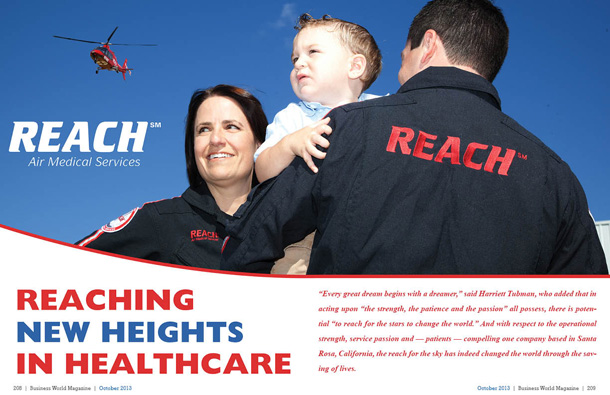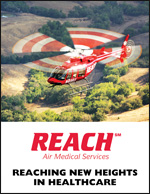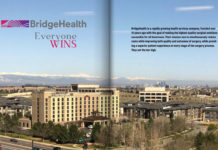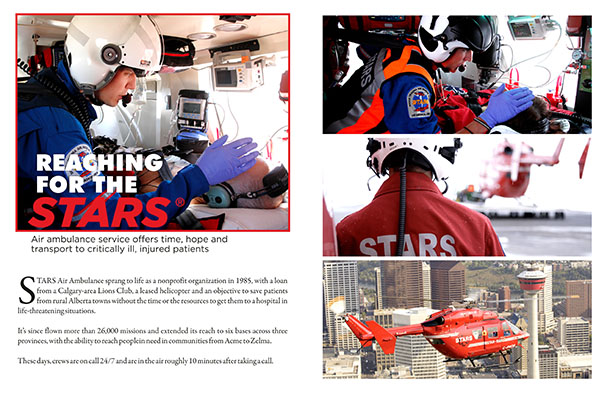
Reaching New Heights in Healthcare

“Every great dream begins with a dreamer,†said Harriett Tubman, who added that in acting upon “the strength, the patience and the passion†all possess, there is potential “to reach for the stars to change the world.†And with respect to the operational strength, service passion and –– patients –– compelling one company based in Santa Rosa, California, the reach for the sky has indeed changed the world through the saving of lives.
REACH Air Medical Services is an air ambulance service that launched to life a little more than 25 years ago by focusing on the needs of patients near its headquarters in the Sonoma County, California, community of Santa Rosa. Today, however, its flight operations extend throughout the state and even reach into Oregon and Texas. In addition to fulfilling emergency medical airlift needs, Reach specializes in a range of inter-facility transports essential to critically ill/injured adults as well as high risk obstetric, neonatal and pediatric patients. Beyond its composite of helicopters and fixed-wing assets, Reach deploys a cadre of the industry’s most capable and credentialed of medical personnel; clinicians who not only hold certification in Basic Life Support, but also Advanced Cardiac Life Support, Pediatric Advanced Life Support, Neonatal Resuscitation and Trauma care. Reach expertise in the imparting of care as well as its operational quality has been routinely recognized as reflecting the industry’s highest standards, having been rigorously reviewed as consistent with mandates of the Commission on Accreditation of Medical Transport Systems (CAMTS), an independent authority which has awarded Reach with accreditation for the last 11 consecutive years. In terms of its service delivery, to be sure that involves much more than a simple flight by plane or helicopter. “We really see ourselves more as a healthcare company … a healthcare company with wings,†affirms Vice President of Public Relations and Business Development Anna Blair.
A Reach Back in Time
Reach Air Medical Services was founded by the late Dr. John L. McDonald, a pioneering, visionary of healthcare services in California whose credits not only include creating the first emergency medical department at Memorial Hospital in Santa Rosa, but also establishing the first Paramedic Program in Sonoma County. Reach Director of Operations Vicky Spediacci says Dr. McDonald had a unique passion for field medicine, yet was also an aviation enthusiast. “He viewed aviation as vital to the support of field medicine … paramedics have skills and in an emergency, the closer you could connect patients with those skills before transporting them to a care facility, the better recovery rates are. There was also the time factor… there wasn’t a lot of freeway infrastructure, and you could put someone on a ground ambulance or put them in an aircraft and save time,†says Spediacci. McDonald was also determined to create a regional trauma center and he felt in order for that effort to get off the ground, an air medical service had to be established. Reach was established in 1987 through a partnership with an area hospital. Operations began with a single Augusta 109A helicopter, yet after a short time, the service was deemed too costly to maintain and the hospital abandoned the service. Spediacci says McDonald was so dedicated to Reach Air Medical that he took it under his own wings, assuming all responsibility and financial risks to fund the program on his own means. McDonald ultimately passed in 2000, living just long enough to ultimately see Santa Rosa Memorial Hospital earn distinction as a Level II Trauma Center. Through his private practice and hospital services, McDonald’s legacy in healthcare has beneficially impacted hundreds of thousands of adults, children and families throughout Sonoma County, and more than 50,000 patients have received critical care and transport by Reach Air Medical Services. Today, REACH has bases in Concord, Imperial, Lakeport, Marysville, Redding, Sacramento, Santa Rosa, Stockton, Thermal and Upland, California, as well as Corvallis, Oregon, and Texas. And though the company has increased its wing assets and expanded its reach into different markets over the changing of time, the company has refused to waver from the values with which it was founded. Those values, according to Blair, revolve around “a guiding principle to always do what is right for the patient.†Adherence to that principle has not only prompted dedication to licensed training in the range of scenarios which staff may encounter and investment in state-of-the-art technology and tools to effectively aid in the imparting of care or increasing of operational efficiency, doing what is right has ultimately driven a collection of pilots, medical clinicians, communication and maintenance technicians to all work together as a team. Whereas some companies may outsource aspects of their operational services, Blair says Reach maintains its own fleet, as well as it flight teams, communications specialists and maintenance crews. “It is one company from end to end … and that’s allowed us to stay who we are and maintain the values of our culture,†says Blair.
Advanced Ops
Operationally, Director of Clinical Services Greg Taylor says each Reach flight combines skill sets of a Registered Nurse and Licensed Paramedic. “We do that for specific reasons,†says Taylor. “An R.N. is accustomed to working in a hospital setting, closely with patients, physicians and lab services. Paramedics are accustomed to being in the field and effectively dealing with any chaos that might occur in responding to a 9-1-1 emergency, those skills come together to best meet the needs of the patient.†And though Reach does routinely respond to 9-1-1 emergencies, in many other cases, they are simply the go-to care providers requested by fire, police and other local agencies. Over time, hospitals have also increasingly relied on Reach for inter-facility transports, occasions when a patient has to transition from care at one hospital to more specialized care at another hospital. Taylor says Reach has exacted critical expertise in high risk transfers involving obstetric, neonatal and pediatric patients,
this care constitutes an area of specialization for the company and its practices are recognized as the best within the industry. Some air units are equipped with isolettes crucial to neonatal patients, such as premature or critically ill infants. “We have the material resources along with the trained staff to provide the same quality of care that one might expect to encounter at a hospital’s neonatal intensive care unit,†says Taylor.
Capability in Communications
While Reach services certain involve “going above,†this enterprise has gone beyond in terms of providing services emerging from its communication operations, in fact, Communications Director Brian Bricker says Reach was the first air service in the country to deploy satellite-radio communication systems throughout its entire fleet. Its communication center ultimately serves as more than a dispatch coordinator, but actually helps hospitals determine where patients can be transferred when the situation calls for it. As Bricker explains, a hospital may have a patient whose care needs require a specialized facility or physician. Operators in the communication center, help the hospital staff identify admission alternatives in terms of location and bed availability. “This is a big focus of our day to day operations … being able to quickly and competently provide information to hospitals and EMS agencies … they’re calling us voluntarily and we strive to provide them with the best customer service experience in each interaction, but it also helps ensure we’re sending the most appropriate mode of transport with the most appropriate staff to respond to that need… yet whether we transport the patient or not, we can help the hospital identify the location of specialty care, bed-type and the appropriate receiving doctor,†explains Bricker.
Reach has also devised solutions to eliminate what Bricker describes as a familiar frustration in healthcare, known as “The Black Hole of Transport.†Basically, he says too often, hospitals will arrange for air transport only to be put a stand-by position with no clear understanding of the space ocf time before the service arrives. “Depending on who they call, there may be over communication or under communication, but it is very frustrating for the physicians when they don’t know what is happening or how long it will take for the transport to arrive,†says Bricker.
To overcome this, Bricker says hospitals served by Reach Air Medical each receive a customized computer tablet equipped with a handy application enabling them to not only see the status of the call in real time, but watch each stage of the transport to and from the facility as it occurs, complemented with a map, GPS location and a clock that counts down to arrival. “We found this solution offers constant visibility and accountability to our customers, and they appreciate that,†says Bricker.
Reaching into the Future
After 25 years of distinguished service, Reach is positioned for further growth and greater service as it has been assimilated by a company known as Air Medical Group Holdings, recognized as the largest independent provider of air medical services in the world. Through its subsidiaries, Air Medical Group Holdings maintains the industry’s largest fleet of medically-equipped, long range helicopters and fixed-wing units, and more than 220 operating bases throughout the country. Spediacci says Reach has been empowered with several advantages through the relationship with Air Medical Group. On one hand, the scalability provides Reach with a buying power in terms of health insurance, aircraft insurance and other operating costs. She says that by achieving savings, Reach is better able to pass those savings on to its customers. More importantly, Reach has now achieved new means to rapidly accommodate capital improvement. “Under former ownership, having capital for replacement aircraft was a time consuming process … and though our helicopters have served us well for more than 20 years, the relationship with Air Medical Group Holdings has significantly helped us to make necessary upgrades to our fleet,†says Spediacci, adding that Reach has recently acquired three new helicopters.
Blair also notes that a membership program created by Reach has now been expanded into the 85,000 member strong program affiliated with Air Medical. Through membership in the program, a company or a family has access to air medical transport services from the more than 220 bases established throughout the country. In the case of any emergency or critical needs, should a club member require medical air service, no transport fees will be assessed. Members simply pay an annual club fee ranging from $55 for individual to $65 that covers anyone in their family. “That’s a huge benefit and a great deal of assurance in an emergency because Members access services from 220 bases across the country, and club membership are significantly less than what a transport might cost otherwise,†explains Blair.
She adds that Reach is currently working to expand its club membership program, while also intently observing the changing dynamics in healthcare prompted legislative reforms. Blair expresses confidence that Reach will continue to reach its goals in terms of market service coverage as well as the continuity of its service quality. As Blair says, “At the end of the day, our focus is making the right choices for patients … doing the right thing to help the patient … that has helped guide our business decisions in the past and will continue to guide us as we move forward.â€
For more information, please visit their website at: Â Â Reach Air Medical Services
Preferred Vendors of Choice:








